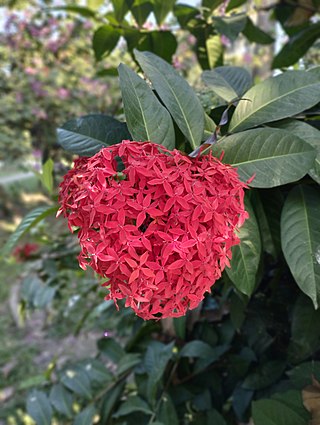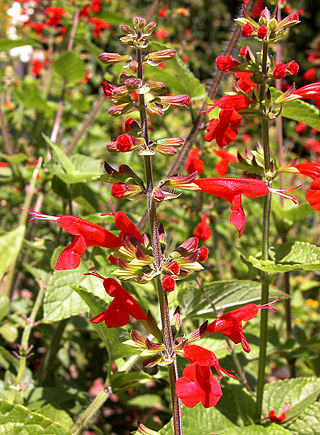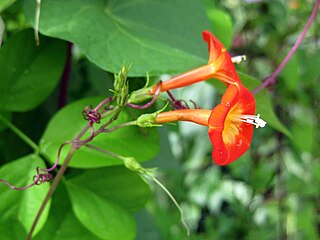
Amaranthus is a cosmopolitan group of more than 50 species which make up the genus of annual or short-lived perennial plants collectively known as amaranths. Some of the better known names include "prostrate pigweed" and "love lies bleeding". Some amaranth species are cultivated as leaf vegetables, pseudocereals, and ornamental plants.

Rubiaceae is a family of flowering plants, commonly known as the coffee, madder, or bedstraw family. It consists of terrestrial trees, shrubs, lianas, or herbs that are recognizable by simple, opposite leaves with interpetiolar stipules and sympetalous actinomorphic flowers. The family contains about 14,100 species in about 580 genera, which makes it the fourth-largest angiosperm family. Rubiaceae has a cosmopolitan distribution; however, the largest species diversity is concentrated in the tropics and subtropics. Economically important genera include Coffea, the source of coffee; Cinchona, the source of the antimalarial alkaloid quinine; ornamental cultivars ; and historically some dye plants.

Dahlia is a genus of bushy, tuberous, herbaceous perennial plants native to Mexico and Central America. Dahlias are members of the Asteraceae family of dicotyledonous plants, its relatives include the sunflower, daisy, chrysanthemum, and zinnia. There are 49 species of dahlia, with flowers in almost every hue, with hybrids commonly grown as garden plants.

The Jerusalem artichoke, also called sunroot, sunchoke, wild sunflower, topinambur, or earth apple, is a species of sunflower native to central North America. It is cultivated widely across the temperate zone for its tuber, which is used as a root vegetable.

The ʻiʻiwi or scarlet honeycreeper is a species of Hawaiian honeycreeper. The ʻiʻiwi is a highly recognizable symbol of Hawaiʻi.

Alstroemeriaceae is a family of flowering plants, with 254 known species in four genera, almost entirely native to the Americas, from Central America to southern South America. One species of Luzuriaga occurs in New Zealand, and the genus Drymophila is endemic to south-eastern Australia.

Ipomoea is the largest genus in the plant family Convolvulaceae, with over 600 species. It is a large and diverse group, with common names including morning glory, water convolvulus or water spinach, sweet potato, bindweed, moonflower, etc. The genus occurs throughout the tropical and subtropical regions of the world, and comprises annual and perennial herbaceous plants, lianas, shrubs, and small trees; most of the species are twining climbing plants.

Quercus coccinea, the scarlet oak, is a deciduous tree in the red oak section Lobatae of the genus Quercus, in the family Fagaceae.

Banksia coccinea, commonly known as the scarlet banksia, waratah banksia or Albany banksia, is an erect shrub or small tree in the family Proteaceae. Its distribution in the wild is along the southwest coast of Western Australia, from Denmark to the Stokes National Park, and north to the Stirling Range, growing on white or grey sand in shrubland, heath or open woodland. Reaching up to 8 m (26 ft) in height, it is a single-stemmed plant that has oblong leaves, which are 3–9 cm (1.2–3.5 in) long and 2–7 cm (0.8–2.8 in) wide. The prominent red and white flower spikes appear mainly in the spring. As they age they develop small follicles that store seeds until opened by fire. Though widely occurring, it is highly sensitive to dieback and large populations of plants have succumbed to the disease.

Ixora is a genus of flowering plants in the family Rubiaceae. It is the only genus in the tribe Ixoreae. It consists of tropical evergreen trees and shrubs and holds around 544 species. Though native to the tropical and subtropical areas throughout the world, its centre of diversity is in Tropical Asia. Ixora also grows commonly in subtropical climates in the United States, such as Florida where it is commonly known as West Indian jasmine.

Amorphophallus paeoniifolius, the elephant foot yam or whitespot giant arum, is a tropical plant native to Island Southeast Asia. It is cultivated for its edible tubers in Southeast Asia, South Asia, Madagascar, New Guinea, and the Pacific islands. Because of its production potential and popularity as a vegetable in various cuisines, it can be raised as a cash crop.

Ixora coccinea is a species of flowering plant in the family Rubiaceae. It is a common flowering shrub native to Southern India, Bangladesh, and Sri Lanka. It has become one of the most popular flowering shrubs in South Florida gardens and landscapes. It is the national flower of Suriname. Commercially important medicinal plant, used in ayurveda. All parts including flower, leaves and root are taken for various medicinal preparations for skin disease, Diabetes etc.

Brownea coccinea is a species of small evergreen tree with compound leaves and clusters of bright scarlet flowers in the subfamily Detarioideae of the family Fabaceae. Common names include scarlet flame bean, mountain rose, rose of Venezuela and cooper hoop. The species is native to Colombia, Ecuador and Venezuela.

Salvia coccinea, the blood sage, scarlet sage, Texas sage, or tropical sage, is a herbaceous perennial in the family Lamiaceae that is widespread throughout the Southeastern United States, Mexico, Central America, the Caribbean, and northern South America. At one time Brazil was considered to be where it originated, but its diploid chromosome count now points to Mexico as its place of origin.

Boerhavia coccinea is a species of flowering plant in the four o'clock family which is known by many common names, including tar vinescarlet spiderling and red boerhavia.

Ornamental bulbous plants, often called ornamental bulbs or just bulbs in gardening and horticulture, are herbaceous perennials grown for ornamental purposes, which have underground or near ground storage organs. Botanists distinguish between true bulbs, corms, rhizomes, stem tubers and tuberous roots, any of which may be termed "bulbs" in horticulture. Bulb species usually lose their upper parts during adverse conditions such as summer drought and heat or winter cold. The bulb's storage organs contain moisture and nutrients that are used to survive these adverse conditions in a dormant state. When conditions become favourable the reserves sustain a new growth cycle. In addition, bulbs permit vegetative or asexual multiplication in these species. Ornamental bulbs are used in parks and gardens and as cut flowers.

Ipomoea coccinea is a flowering plant in the family Convolvulaceae known by several common names including red morning glory, redstar and (ambiguously) Mexican morning glory.

Passiflora coccinea is a fast-growing vine. The vine is native to northern South America. It produces edible fruit.

Dahlia imperialis, or bell tree dahlia, is a large flowering plant of the family Asteraceae, native to the Americas.

Dahlia pinnata is a species in the genus Dahlia, family Asteraceae, with the common name garden dahlia. It is the type species of the genus and is widely cultivated.




















